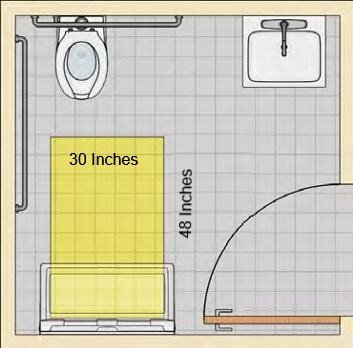Accessible Baby and Adult Changing Tables and the ADA
Baby Changing Table in Open Position
Accessible changing tables for babies and adults in Title II and Title III facilities are required to comply with the Americans with Disabilities Act (ADA). This article will discuss the ADA scoping and technical requirements for toilet and bathing facilities with accessible baby and adult changing tables in State and local government facilities, public accommodations, and commercial facilities. 2010 ADA Standard 226 covers scoping requirements and Standard 902 covers technical requirements for accessible changing tables. The photo above is representative of a toilet facility with a baby changing table.
While baby changing tables are becoming common in toilet and bathing rooms, adult changing tables are also starting to be found. Clearly if an adult changing table can be used for an adult it can also be used for a child. The photo below is representative of an adult changing table.
Adult Changing Table Photo from 90.5 Pittsburgh's NPR News Station
In each case, baby and adult changing tables should be considered work surfaces when installed in Title II and Title III facilities. As a work surface, these installations must comply with the ADA including the Standards for protruding objects.
Scoping Requirements
2010 ADA Standard 226.1, [Dining Surfaces and Work Surfaces] General, states, ”… where work surfaces are provided for use by other than employees, at least 5 percent shall comply with [Standard] 902.” Because the ADA considers changing tables to be work surfaces, these changing tables must meet these requirements in each space they are found.
2010 ADA Standard 226.2, [Dining Surfaces and Work Surfaces] Dispersion, states, “Dining surfaces and work surfaces required to comply with [Standard] 902 shall be dispersed throughout the space or facility containing dining surfaces and work surfaces.”
In other words, if you have changing tables in your facility that has multiple toilet or bathing rooms, changing tables should be dispersed throughout the facility. And because toilet rooms are commonly separated between Men and Women, if one toilet room has a changing table, the other toilet room should have a changing table as well, in order to satisfy the requirements for dispersion. This assumes that both toilet rooms have the space required to include a changing table. It is best to locate changing tables so that they are easy to use by people with disabilities. Since toilet stalls can be small in floor space, avoid placement in toilet compartments (stalls) for easier access.
Technical Requirements
Technical requirements for changing table installations are covered in 2010 ADA Standard 902, Dining Surfaces and Work Surfaces. The graphic below is representative of the technical requirements for a changing table installation.
2010 ADA Standard 902.1, [Dining Surfaces and Work Surfaces] General, states, “Dining surfaces and work surfaces shall comply with [Standards] 902.2 and 902.3.” The 2010 ADA Standards Advisory for 902.1 states that examples of work surfaces include baby changing and other tables or fixtures for personal grooming.
2010 ADA Standard 902.2, [Dining Surfaces and Work Surfaces] Clear Floor or Ground Space, states, “A clear floor space complying with [Standard] 305 positioned for a forward approach shall be provided. Knee and toe clearance complying with [Standard] 306 shall be provided.” The graphic below is a plan view of the clear space for a baby changing table in a toilet room. This clear space can overlap other fixture clearances and door maneuvering clearances, but the changing table itself cannot overlap the door maneuvering clearance.
Plan View of Clear Space for Baby Changing Table
The graphic below is representative of knee and toe space required by Standard 306 below the table when it is in the open/down position.
Knee and Toe Space
2010 ADA Standard 902.3, [Dining Surfaces and Work Surfaces] Height, states, “The tops of dining surfaces and work surfaces shall be 28 inches (710 mm) minimum and 34 inches (865 mm) maximum above the finish floor or ground.”
Because the table surface has to be lowered to use it, this surface is also considered an operable part and has to comply with ADA Standard 309 as such. 2010 ADA Standard 309 requires the table surface to be:
protected by a clear space with a forward approach
within one or more of the reach ranges specified in 308 (usually 48 inches maximum above the finished floor)
operable with one hand
operable without tight grasping, pinching, or twisting of the wrist
operable with a force of 5 pounds maximum
Changing tables cannot overlap fixture clearances or door maneuvering clearances when stowed. The graphic below is representative of a stowed baby changing table in a toilet room. Shown in the graphic is the clearance required around the toilet and the door maneuvering space.
Baby Changing Table and Toilet Clearance and Door Maneuvering Space
SUMMARY
Changing tables for babies and adults in Title II and Title III facilities are required to comply with the Americans with Disabilities Act. These tables are considered work surfaces in the eyes of the ADA. As work surfaces, changing tables must comply with the ADA Standards for clear spaces, reach ranges, operable parts, height above the floor, protruding objects, knee and toe space below the table when open/down, and dispersion within a facility.
……………………………………………………………………………………………………………………………………………………………………………







